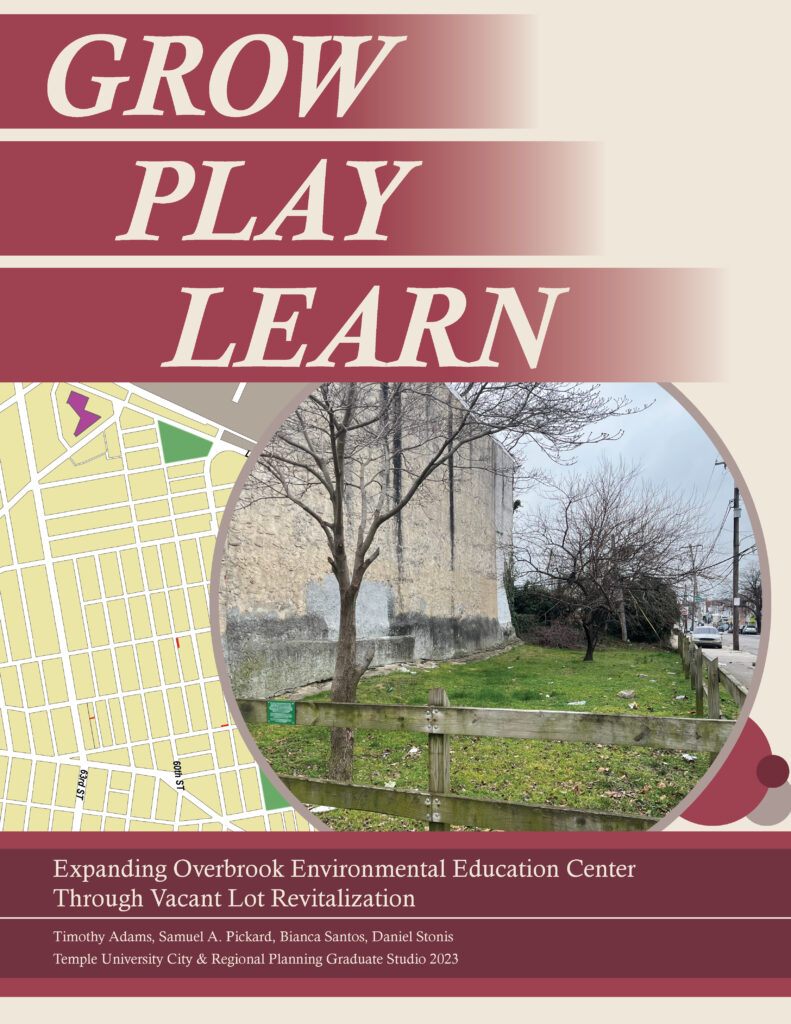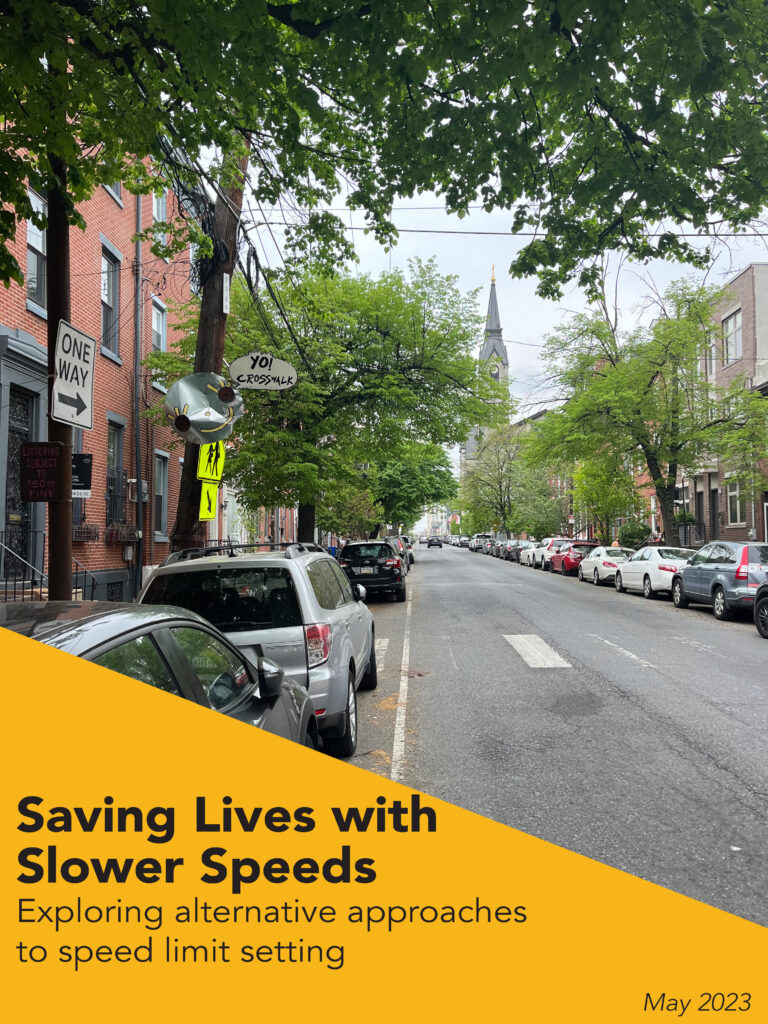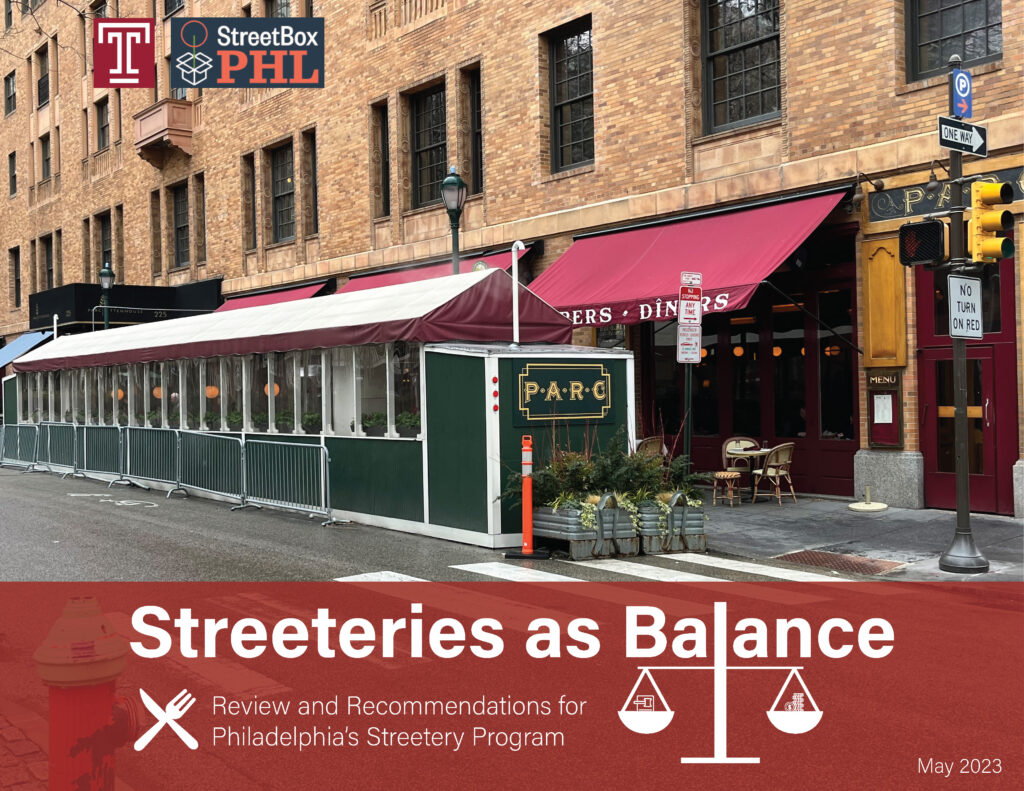In 2023, ten graduate planning students collaborated on three studio projects. The projects reflect the breadth of Temple’s program, and the strong community engagement central to our practice. One team worked with Overbrook Environmental Education Center to develop a plan to re-purpose vacant lots as an extension of their campus. The second team partnered with DVRPC in research on the best practices to set safe speed limits, in furtherance of Vison Zero goals. And our third team researched Philadelphia’s Street Eatery program, a response to the COVID-19 pandemic which has recently been adopted as a permanent program.

The Overbrook Environmental Education Center (OEEC) is a community-based non-profit that provides environmental educational services to zip codes 19131, 19139, and 19151 in northern West Philadelphia. OEEC proposes to expand its campus and educational reach through the repurposing of vacant lots in the OEEC service area. The repurposing of the vacant lots will serve a need to disadvantaged populations affected by disinvestments for the past half-century.
The OEEC revitalized lots are intended to serve as a well-connected “expansion” of the main Lancaster Avenue campus; further extending its educational reach into the surrounding neighborhoods while providing residents increased access to recreational and outdoor spaces, tools for building sustainable living practices, and educational resources geared toward youth comprehension of the local environment and its ecology.
The OEEC has tasked Temple University’s City & Regional Planning Graduate Studio (TUGS) with exploring the best practices for each of the nine conceptual lot types and potential strategies for linking them into a disconnected park system. In addition to studying the best practices for each designer lot concept, the TUGS team developed a site suitability matrix that could be used to quickly analyze whether a given vacant lot would be suitable for the placement of one of OEEC’s designer lots. The team applied this suitability matrix to 43 city-owned vacant lots using digital and field survey data through field survey. A further analysis was conducted on a final list of 11 city-owned lots provided by the OEEC, gauging the suitability of each of the lots for the nine designer lot concepts. The TUGS team found that 10 of the 11 vacant lots on the final list would be acceptable candidates for designer lot concept implementation, though certain lots are better suited to some concepts than others. Additional considerations have been made in accordance with the organizational standards set by the Overbrook Environmental education Center.
Full Report [PDF]
Executive Summary [PDF]
Presentation to OEEC [PDF]

Every year, hundreds of people die in car crashes in the Philadelphia region and many of these crashes involve cars traveling at unsafe speeds. Unfortunately, Philadelphia does not have a framework nor the authority to set safe and appropriate speed limits. Instead, they must follow outdated rules and regulations set by the State. This limited power prevents the City of Philadelphia from keeping their citizens safe. Since the 1860s, there have been several approaches to speed limit setting (SLS) that have developed over time in response to emerging trends and technology. Now, in 2023, the Safe System approach mindset along with innovative trends and technology allows jurisdictions to analyze individual roads to determine a safe speed.
In order to gain state granted authority over speed limit setting, evidence in support of innovative best practices needs to be researched. The City of Philadelphia’s Office of Transportation, Infrastructure, and Sustainability (OTIS) asked the Delaware Valley Regional Planning Commission (DVRPC) for assistance to create a report that addresses these needs. DVRPC developed a two-pronged approach for this study, the first part being this report, completed by Temple University City and Regional Planning Graduate Students. This project identifies how cities have gained authority to regulate their speed limits, provides details about alternative speed limit setting approaches, and offers an analysis on how these methods can be adopted across Philadelphia. Lastly, because new approaches to speed limit setting has been gaining momentum and jurisdictions are struggling to identify best practices, it will detail recommendations that the City can implement to become a model city for speed limit setting. Following this study, DVRPC and the City will shortlist approximately five pilot corridors to test slower speed limits. The findings of the study will be applied to meet DVRPC’s 2050 regional Vision Zero goal.
Full report [PDF]
Executive Summary [PDF]
Presentation to DVRPC and OTIS [PDF]

In March 2020, the rapid spread of the novel coronavirus (COVID-19) led to a national pandemic response in the United States which included restrictions for public gatherings, especially in indoor spaces. Many cities responded by reclaiming space outdoors for a variety of activities. The City of Philadelphia created the Temporary Outdoor Dining Program to allow businesses to use adjacent parking spaces in front of their establishment for dining operations and other activities. Due to the location in the street, outdoor dining setups came to be known as street eateries, or streeteries. The restrictions on indoor dining and public gatherings indoors became a lifeline for many businesses throughout the pandemic. Streeteries occupy space in the publicly-owned right-of-way with tables, chairs, and structures for additional dining capacity.
As the pandemic restrictions loosened and indoor dining returned to a pre-pandemic state, streeteries remained popular for restaurant operators and patrons. However, issues started to emerge. The presence of streeteries complicated utility access, reduced the capabilities of emergency respondents, and presented new regulatory challenges for Philadelphia. To maintain the streetery program and address the issues from the temporary regulations, Philadelphia introduced its Permanent Outdoor Dining Program. The Permanent Outdoor Dining Program updated regulations to address issues stemming from the Temporary Outdoor Dining Program and establish streeteries as a long-term fixture on Philadelphia’s streets. Streeteries provide an exciting opportunity for restaurant operators, the City of Philadelphia, and the public. While streeteries do provide some benefits, they also create various problems. A renewed focus on opportunity and equity will provide the necessary foundation to form the next iteration of streetery regulations.
Our report analyzes and reviews streeteries in Philadelphia from 2020 to 2023 with the goal of providing recommendations that improve equitable access to streeteries to optimize their benefits and maintain balance between the needs of operators, the City of Philadelphia, and the public.
Full report [PDF]
Executive Summary [PDF]
Presentation to StreetBox PHL [PDF]